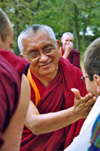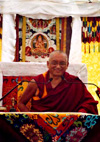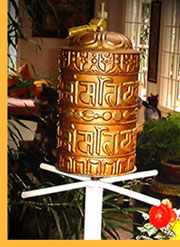In
Solu Kumbu, all the old men and women turned prayer wheels everyday.
When they are at home in the morning and in the evening before
they go to bed, they hold a mala in their left hand, a
prayer wheel in their right, and recite om mani padme
hung. And when they walk around, they constantly turn the
prayer wheel and recite om mani padme hung.
I often
used to think, "How does turning of the prayer wheel
become Dharma practice?"
I had this
question in my mind, simply because I was ignorant of the benefits
of the practice. I didn't know what an important practice it
is and how beneficial it is in terms of purification. Just touching
and turning a prayer wheel brings incredible purification and
accumulates unbelievable merit.

At Lawudo I found many old
manuscripts, handwritten texts by the Lawudo Lama. The
previous Lawudo Lama was called Lama (Kunsang) Yeshe and some
people think he has something to do with my life. The Lawudo
Lama did not have a monastery, but lived in retreat in a cave.
He put a lot of effort into copying texts of the practices of
varies Vajrayana deities. At that time such texts were very
rare, so he wrote many out by hand. Because they had been stored
in the cave which was very humid, the texts were damp, and I
used to dry them in the sun. If you don't dry them, the texts
grow fungus and are then destroyed by worms. The worms reincarnate
among the texts and make some interesting holes in them.
One day when I was laying the texts
out in the sun, I saw one old text with the title Mani Kabum.
It contains all the history of the evolution of the world, including
how Dharma came into this world and how the sentient beings
of Tibet, the Snow Land, became the particular objects to be
subdued by the Compassion Buddha Avalokiteshvara. Amitabha
and the Compassion Buddha are the same in essence and are very
strongly linked. The Compassion Buddha and Amitabha have guided
not only Tibet and China, but also Western countries, especially
by spreading Dharma. In Mani Kabum I saw a short explanation
of the lineage of the prayer wheel practice and a few lines
on how to visualize and meditate when you do the practice.
In Tibet, and generally wherever there are the Mahayana teachings
of Vajrayana, the practice of the prayer wheel has spread. Nagarjuna
gave the practice to Lion-faced Dakini, who gave it to Padmasambhava,
who then brought it to Tibet. After reading this, I developed
faith that the practice was not nonsense, but had valid references
and was valuable and meaningful. From this text, I got some
idea of how powerful the prayer wheel practice is in purifying
the mind and in accumulating extensive merits.
In 1987,
when I was at Chenresig Institute in Australia,
I noticed that the place had become incredibly peaceful. It
felt so serene that you wanted to be there, to live there. Chenresig
Institute had not been like that before, and I wondered why
it had changed. At that time, Geshe Lama Konchog was
there. Geshe-la has done a lot of Dharma practice. After he
escaped from Tibet, he spent many years in retreat in Milarepa's
caves in the Himalayas. He did 2000 Nyung-nays, the intensive
two-day retreat on the Compassion Buddha, that involves taking
the eight Mahayana Precepts and doing many prostrations and
mantras. Geshe Lama Konchog has trained his mind well in the
path, so I thought that the serenity of Chenresig Institute
might be due to his Bodhicitta.
 One day near the end of my stay there, the thought came into
my mind, "Oh, the change might be due to the prayer
wheel, it wasn't there before." The prayer wheel is
much smaller than the one here at Land of Medicine Buddha, but
it also contains many mantras on microfilm and is very
nicely made. Some time later, when I was in Brazil at
the invitation of a meditation center there, a student gave
me a book written by one of Tarthang Tulku's senior disciples
about his experiences when he was in charge of building stupas
and prayer wheels in Tarthang Tulku's centers. In one section
he mentioned that after a prayer wheel was built, the area
was completely transformed, becoming so peaceful, pleasant,
and conducive to the mind.
One day near the end of my stay there, the thought came into
my mind, "Oh, the change might be due to the prayer
wheel, it wasn't there before." The prayer wheel is
much smaller than the one here at Land of Medicine Buddha, but
it also contains many mantras on microfilm and is very
nicely made. Some time later, when I was in Brazil at
the invitation of a meditation center there, a student gave
me a book written by one of Tarthang Tulku's senior disciples
about his experiences when he was in charge of building stupas
and prayer wheels in Tarthang Tulku's centers. In one section
he mentioned that after a prayer wheel was built, the area
was completely transformed, becoming so peaceful, pleasant,
and conducive to the mind.
This confirmed my belief, based
on my own reasoning, that Chenresig Institute had become so
peaceful because of its new prayer wheel. Somebody else experiencing
a similar effect from building the prayer wheel helped to stabilize
my faith.
















Next
Page







 One day near the end of my stay there, the thought came into
my mind, "Oh, the change might be due to the prayer
wheel, it wasn't there before." The prayer wheel is
much smaller than the one here at Land of Medicine Buddha, but
it also contains many mantras on microfilm and is very
nicely made. Some time later, when I was in Brazil at
the invitation of a meditation center there, a student gave
me a book written by one of Tarthang Tulku's senior disciples
about his experiences when he was in charge of building stupas
and prayer wheels in Tarthang Tulku's centers. In one section
he mentioned that after a prayer wheel was built, the area
was completely transformed, becoming so peaceful, pleasant,
and conducive to the mind.
One day near the end of my stay there, the thought came into
my mind, "Oh, the change might be due to the prayer
wheel, it wasn't there before." The prayer wheel is
much smaller than the one here at Land of Medicine Buddha, but
it also contains many mantras on microfilm and is very
nicely made. Some time later, when I was in Brazil at
the invitation of a meditation center there, a student gave
me a book written by one of Tarthang Tulku's senior disciples
about his experiences when he was in charge of building stupas
and prayer wheels in Tarthang Tulku's centers. In one section
he mentioned that after a prayer wheel was built, the area
was completely transformed, becoming so peaceful, pleasant,
and conducive to the mind.